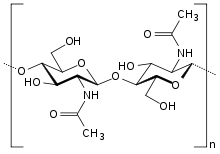Team:Northwestern/Project/Chitin Synthesis
From 2010.igem.org
| Line 157: | Line 157: | ||
[[image:chitin_wikipedia.png|frame|right|alt=alt text|'''Figure 1''' Chitin molecular structure. <br /> Source: [http://en.wikipedia.org/wiki/Chitin Wikipedia - Chitin]]] <br /> | [[image:chitin_wikipedia.png|frame|right|alt=alt text|'''Figure 1''' Chitin molecular structure. <br /> Source: [http://en.wikipedia.org/wiki/Chitin Wikipedia - Chitin]]] <br /> | ||
| + | |||
| + | |||
| + | '''SIGNIFICANCE OF CHITIN''': | ||
| + | |||
| + | <u>Medicinal Use</u>: | ||
| + | |||
| + | *Wound and burn treatment/healing | ||
| + | *Hemostasis for orthopedic treatment of broken bones | ||
| + | *Viscoelastic solutions for ophthamology and orthopedic surgery | ||
| + | *Abdominal adhesion treatment | ||
| + | *Antibacterial and antifungal agents | ||
| + | *Tumor therapies | ||
| + | *Microsurgery and neurosurgery | ||
| + | *Treatment of chronic wounds, ulcers and bleeding (chitin powder) | ||
| + | |||
| + | <u>Industrial Use</u>: | ||
| + | |||
| + | *Food/Pharmaceutical/Agricultural/Cosmetic thickener, stabilizer | ||
| + | *Agricultural protection | ||
| + | *Water resistant properties | ||
| + | *Dietary supplement | ||
| + | *Water purification | ||
| + | *Biodegradable | ||
| + | *Edible microcrystalline films used to preserve food | ||
| + | *Sequestering of particles (i.e. oil) | ||
Revision as of 19:37, 23 October 2010
| Home | Brainstorm | Team | Acknowledgements | Project | Human Practices | Parts | Notebook | Calendar | Protocol | Safety | Links | References | Media | Contact |
|---|
|
| |||||||||||
|
 Figure 1 Chitin molecular structure. Source: Wikipedia - Chitin
Medicinal Use:
Industrial Use:
Chitin Synthase 3 (CHS3) was cloned out of Saccharomyces Cerevisiae (S.C.) cDNA. CHS3 from S.C. was chosen because the the protein does not require cofactors or activation factors and also because it was determined to be the most active of the Chitin Synthase family. Chitin Synthase polymerizes N-Acetyl-D-Glucosamine, also known as Chitin, with substrate as UDP-N-Acetyl-D-Glucosamine. | |||||||||||
 "
"





